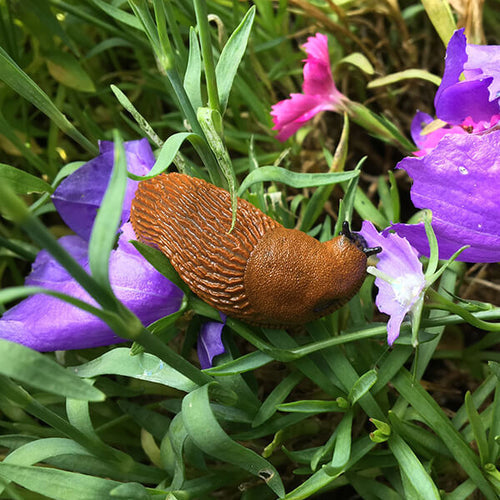Slugs are one of the most common garden pests. If you’re facing an infestation and want non-chemical control, here’s an A–Z of approaches gardeners use to protect plants and reduce damage.
A–Z of Garden Slugs (Tips & Facts)
A — Arion hortensis (Common Garden Slug)
Arion hortensis is a small species (around 3 cm) you’ll often find in UK gardens. Larger species exist too (e.g., great grey slug up to ~20 cm, and the large black slug Arion ater). Whatever the species, all can wreak havoc on tender growth.
B — Beer Traps
Bury a watertight container near vulnerable plants with the rim 2–3 cm above soil (to avoid trapping ground beetles), then half-fill with beer. The scent attracts slugs, which fall in and can’t escape.
Purpose-made trays are neater and safer for pets/wildlife, with lids that still let scent out.

C — Copper Tape
Copper reacts with slug slime to give a mild “tingle,” creating a barrier on pots, raised beds and staging. Keep copper clean (a quick vinegar wipe prevents tarnish) so it works effectively. Try No Go Slug & Snail Tape for easy, cut-to-size strips — ideal around containers. This is a chemical-free way to protect plants.

D — Dead Matter
Slugs scavenge decaying leaves, insects and even small animals — but they’ll also eat new growth. Good hygiene (removing debris) lowers attractants around beds.
E — Eggshells
Crushed eggshells can deter slugs by creating a sharp barrier and add calcium as they break down. Crushed nut shells can serve a similar role. Results vary, so combine with other methods.
F — Fresh or Powdered Seaweed
Seaweed’s natural salt content helps deter slugs. Lay fresh seaweed or sprinkle powdered seaweed around plants for a nutrient boost and light protection (reapply after rain).
G — Ground Coffee
Use spent coffee grounds (not instant granules) around plants. Many gardeners find higher-caffeine grounds more effective. Some cafés give grounds away free — easy win.
H — How Many Slugs?
Estimates suggest thousands can live in an average garden — it’s why overnight damage can be dramatic. Think integrated control, not one-and-done.
I — Identifying Trails
Slime trails map slug routes to preferred plants and can guide other slugs. Track and break these routes with barriers or traps.
J — Jagged Edges
Ragged, shredded leaf margins = classic slug feeding. Slugs can consume a huge amount relative to body weight, so early action matters.

Fun fact: slugs have ~27,000 microscopic teeth on a flexible band called a radula — it rasps plant tissue as they feed.
K — Knowledge
Slugs can “home” via scent trails. Tossing them a short distance often isn’t enough — relocate far away or combine removal with barriers in key zones.
L — Laying Eggs
Slugs lay clusters (often ~30) in moist, sheltered spots. Warm conditions speed hatching (weeks), cold slows it (months). Disturb hiding places to interrupt cycles.
M — Manual Removal
Create a “collection point” with lettuce leaves or dry cat food in a damp, shady spot. Check at night/early morning and remove what you find. Gloves recommended!
N — Natural Predators
Encourage hedgehogs, thrushes, toads and newts with water, habitat and safe access. Wildlife-friendly gardens keep slug numbers in check.
O — Overnight Citrus Traps
Upside-down grapefruit/orange halves near beds make damp shelters slugs love. Collect and dispose of the rinds (and residents) in the morning.
P — Prickly Barriers
Rings of thorny cuttings, pine needles or crushed shells can discourage soft-bodied slugs from crossing into beds and around prized plants.
Q — Quirky Pets
Some people keep slugs as pets (they’re low-maintenance). For most gardeners though… hard pass. Focus on prevention and habitat management.
R — Rosemary (& Friends)
Plants slugs tend to avoid include rosemary, anise, astrantia, fennel, rue and wormwood. Use companion planting to make beds less appealing.
S — Slippery Surfaces
Spraying the outside of pots with a slick barrier (e.g., WD-40) can make them harder to climb. Test discreetly and reapply after rain.
T — Trails & Tracking
Look for silvery trails in greenhouses, patios and pot sides. They indicate high-traffic routes — target these with traps, barriers or hand-picking.

Science bit: slug slime behaves like a “liquid crystal” — can be both adhesive and lubricating, and it absorbs water.
U — Upper/Lower Tentacles
Upper tentacles handle vision/smell (eyes at the tips); lower tentacles handle touch/taste. They’re retractable and can regrow if damaged.

V — Vapour Rub / Petroleum Jelly
Apply a thin ring on pot exteriors to create a slick, hard-to-cross band. Reapply as needed; avoid leaves/soil contact.
W — Wool Pellets
Wool fibres are barbed, forming an unpleasant surface for slugs. Create protective rings around plants you want to shield.
X — X-Ray View
Slugs lack an internal skeleton; most have a small internal shell fragment storing calcium near digestive glands. Movement comes from a muscular “foot.”
Y — Yearly Pellet Use
Gardeners historically used vast numbers of slug pellets. Consider wildlife-safe options (e.g., ferric phosphate) and prioritise non-chemical controls.
Z — Zzz… Sleep & Hibernation
Slugs don’t follow 24-hour cycles. They nap in bursts and may stay active above ~5 °C. Warmer winters can extend feeding/breeding seasons — plan controls accordingly.

